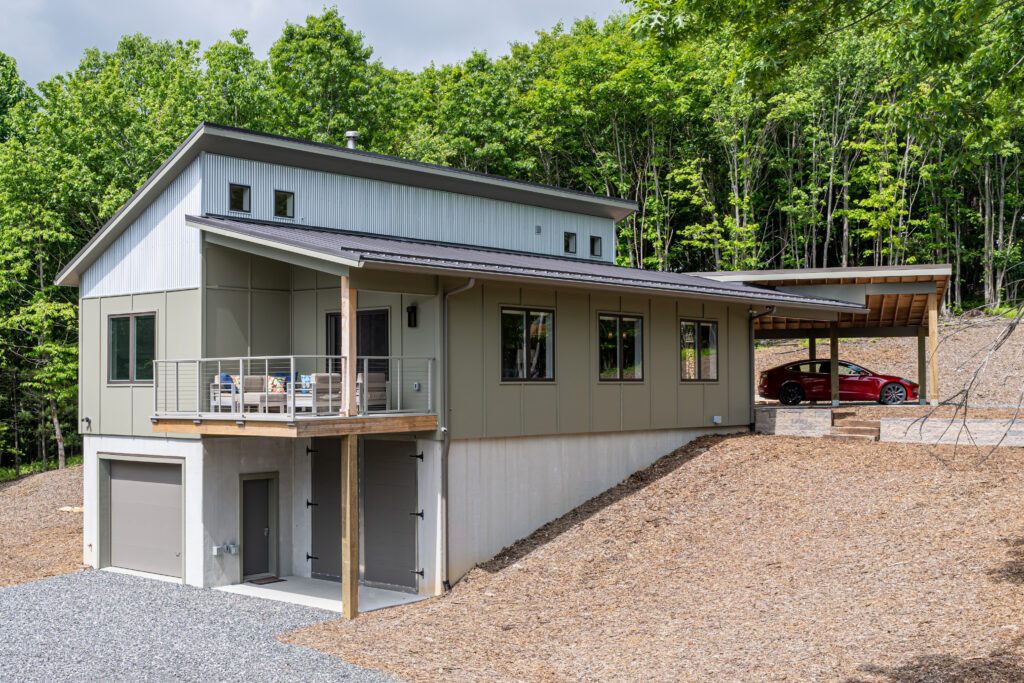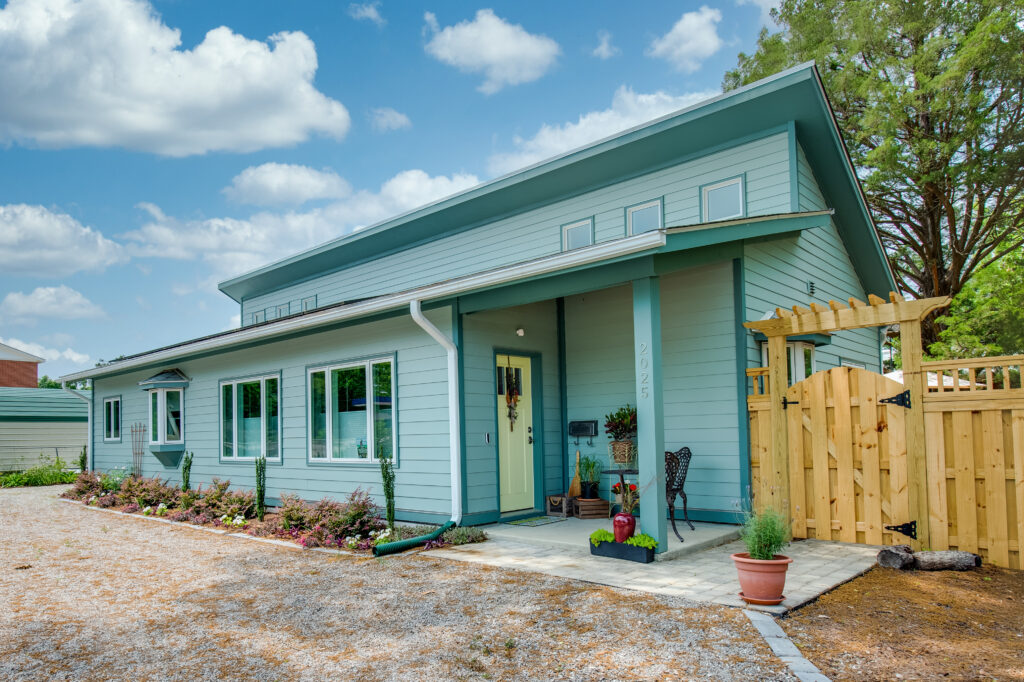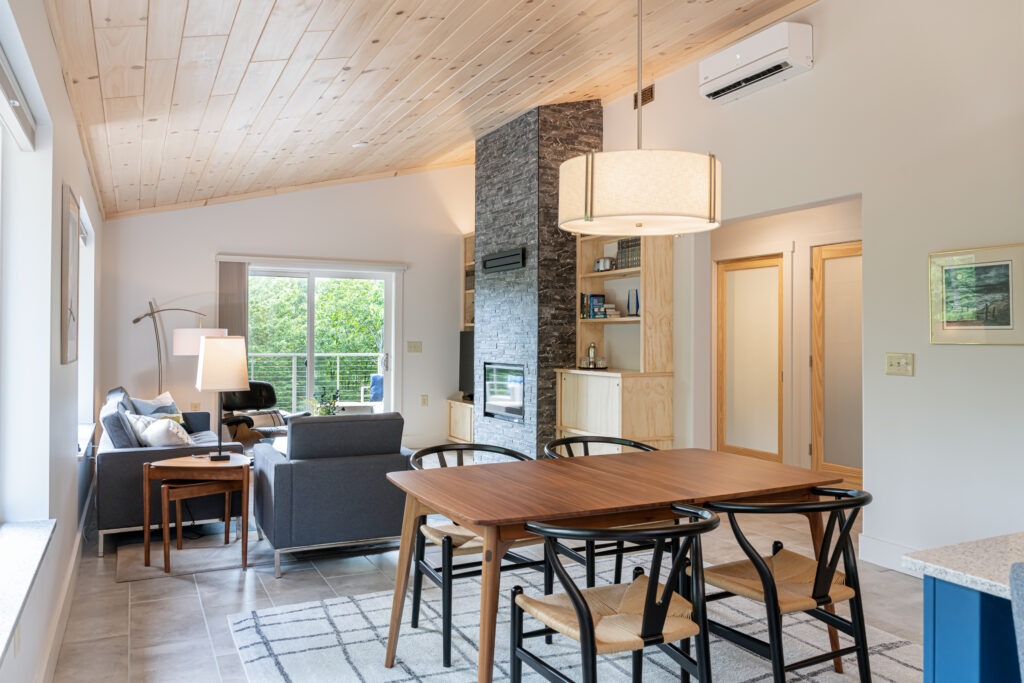Since the launch of our Ridgeline model in 2013, it has been very popular for clients looking for high performance homes. The Ridgeline has been designed intentionally to take advantage of core high performance principles, as well as meet the general design preferences of many homeowners.
However, Ridgelines are also flexible enough to meet individual lifestyle choices, and can offer low energy and healthy living in different types of climates. Let’s look at two examples that help demonstrate how two homeowners in NC built two Ridgelines in very different climatic areas.
An Energy Star Mountain Getaway

Jim and Deb were building a mountain retreat. Located near Boone, NC, their home sits high up in the mountains in a climate zone that is more Northeast than South. They wanted to use the best building science practices to guide them, and had done the research (complete with spreadsheets) to back it up. They had looked into high performance heat pumps for cold climates, passive solar design principles, and ultra efficient appliances. Having seen what was achievable with our recent DOE Zero Energy Ready Home award winner, they felt the design worked well for their goals. With a few design modifications up front (such as stairs to a basement for a drive-under garage), they were off.
Throughout the design process, Jim and Deb worked closely with our green building department, bouncing questions about insulation and air sealing strategies, fresh air ventilation systems, pre-wiring for future solar, and the best way to have a wood stove while preserving air quality, off of our in-house building science consultant. We helped specify the right type of Low-E glass for their south-facing windows to make the most of the inherently passive solar layout of our Ridgeline design–and made sure they had the right amount of thermal mass on the floor to justify that extra heat gain. Minus the wood stove, the home used all-electric appliances, including a combination ducted and ductless mini-split heat pump, a heat pump water heater, and even a heat pump dryer. (If you’re noticing a trend with so many uses of the word “heat pump”, you’re on to something.)
Jim and Deb also understood the importance of the right building process for ensuring a home is built in a high performance way. They used a third-party verification program (In their case, Energy Star for Homes), which offers a list of above-code practices that must be followed, and requires performance testing once the home is complete. This helps ensure that small but critical building science details are not missed. As part of this process, their home was given an energy score through the HERS Index, a way to compare its energy efficiency to standard new construction. A basic new home with no special attention to energy performance might have a HERS score of a 100, while a lower score would indicate a home that is much more energy efficient. Their final HERS score was a 48, indicating a home that is 62% more energy efficient than any old new home on the block.
Now that our homeowners are settled into their home, not only are they excited for their energy savings, but love that they can get it while having a fantastic view towards the distant mountains.
A Coastal Ridgeline Built for Performance

Rich and Janis put the finishing touches on their modified Ridgeline F plan at the start of this year in Wilmington, NC. With the help of their local builder, Old School Rebuilders, they also sought to build a Deltec Home certified to the DOE’s Zero Energy Ready Home Program. Homes built to this challenging program must have only the most effective, practical, and forward thinking building science strategies, such as insulation levels that go beyond current energy codes, high performing comfort systems, fresh air ventilation, efficient water fixtures, and materials design for durability. While many of our homeowners incorporate these elements into their homes, this certification ensures that all elements function well together, and as designed, because they are inspected by a third party, and at the end of the project the home is tested.
They faced a common fundamental challenge when planning their home: what energy sources should they use? Would it be best to incorporate natural gas into the home, or go all-electric? Using a preliminary energy model, we helped them investigate the difference in ongoing energy and fuel service costs between specific natural gas vs electric alternatives for heating, water heating, and cooking. We found, as many customers do, that there are all-electric alternatives to all appliances in the home that come out on top for energy efficiency and for health. All-electric homes can also come out on top in a broader sustainability context, since electricity can be generated from renewable sources, while burning fossil fuels cannot. Sustainability advocates are calling for the rapid electrification of buildings as a critical step in fighting climate change. You can check out this op-ed from EEBA President, Aaron Smith. Using a single fuel source also allows the customers to avoid paying multiple monthly utility service fees. Rich and Janis eventually went with a multi-stage heat pump and ac system, a heat pump water heater, and an induction range. T(Sidebar: induction ranges are gaining converts among professional chefs as a better alternative to gas and are becoming much more popular among those who take cooking seriously.) They even up-sized their solar array to allow for an EV charging station, further electrifying all of their energy use.
Other neat home features include: a “3-season” porch allowing cozy, naturally conditioned extra space (with the help of a wood burning fireplace, kept completely outdoors to avoid introducing combustion pollutants inside the building envelope); a smart thermostat that offers motion sensing control to their hot water re-circulation pump and water leak detection and shutoff capability; a rain garden designed to minimize storm-water and maximize habitat for local pollinators and wildlife (earning the home a second designation as Certified Wildlife Habitat through the World Wildlife Fund); and a smart drip irrigation system integrated with local weather info.
The Bottom Line
Ridgelines, with their ability to harvest passive solar gain in certain climates, are a great pre-designed template upon which to build a high performance home. Yet many of the core strategies to get there–excellent insulation and air-tightness, well-considered heating and cooling systems, total electrification, and following a robust building process that includes a HERS score and a green certification–can be achieved in any home style, round our square. Stay tuned for our next update on two recently-completed, highly sustainable homes from our 360 Collection.

